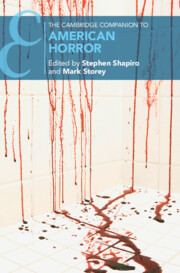Book contents
- The Cambridge Companion to American Horror
- The Cambridge Companion to American Horror
- Copyright page
- Contents
- Acknowledgments
- Contributors
- Introduction
- Part I Histories
- 1 Slavery
- 2 Capitalism
- 3 Religion and Spirituality
- 4 Settlement and Imperialism
- 5 Censorship and State Regulation
- 6 Schlock, Kitsch, and Camp
- Part II Genres
- Index
- Cambridge Companions To …
- References
5 - Censorship and State Regulation
from Part I - Histories
Published online by Cambridge University Press: 21 July 2022
- The Cambridge Companion to American Horror
- The Cambridge Companion to American Horror
- Copyright page
- Contents
- Acknowledgments
- Contributors
- Introduction
- Part I Histories
- 1 Slavery
- 2 Capitalism
- 3 Religion and Spirituality
- 4 Settlement and Imperialism
- 5 Censorship and State Regulation
- 6 Schlock, Kitsch, and Camp
- Part II Genres
- Index
- Cambridge Companions To …
- References
Summary
While rarely at the center of debates around censorship in the United States, horror narratives have been profoundly shaped by pressures to constrain their provocative and shocking nature. This chapter explores the history of censorship efforts by government agencies, media companies, and public organizations and the impact they have had on horror across all forms of media. Tracing these efforts across various media, including literature, comic books, motion pictures, radio, and television, this chapter details the various entities that have tried to constrain the horror genre and the ways horror has adapted to these changing conditions. Throughout this historical period, regulatory efforts have consistently sought to limit shocking imagery and as well as restrict the evocation of feelings of shock and horror. Examining this regulatory history gives insights into the dynamic and evolving public dialogue about the limits of social acceptance and how much transgression society can accept.
- Type
- Chapter
- Information
- The Cambridge Companion to American Horror , pp. 76 - 90Publisher: Cambridge University PressPrint publication year: 2022



